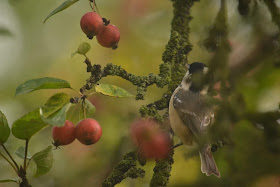It was a fairly quiet Autumn, with no great falls of migrants. The few that did arrive appeared with little fanfare, struggling against an almost constant headwind from the Atlantic that kept the Norfolk coast free from the gawping crowds. On a visit to Stiffkey, the strong winds made for a fairly miserable and somewhat frustrating few hours. The wood at the campsite was damp and empty - until a flurry of Long Tailed Tits suddenly appeared, dragging with them two Yellow-Browed warblers and a buzzing of Goldcrests. Once the flock had moved on, I was left face to face with a pied Flycatcher that soon skulked off into the dense foliage of a thick bush.
The Rain poured.
When it ceased, I wandered along the coastal path. The walk was punctuated by Dunnocks and Linnets, but very little else. A Blackcap, then a Chiffchaff - but then at the whirligig, just as the mizzle started gaining strength again, a small pale brown warbler dashed up from under a gorse branch and was lost in the dense brambles. Booted Warbler! surely! There was absolutely no defining pattern or variation to the bird. No flash of white or glimmer of wing bar. Not grey enough for lesser Whitethroat - no green tones suggesting a typical phyllosc.
The rain poured.
The wind whipped up again, and I was forced to take shelter - there was no way the bird was going to reappear in the immediate future. The shower was over soon, and I hung around, hoping. maybe I should have had the patience to wait at this one patch of bramble until the bird emerged - but this was no balmy summer morning. There's only so long you can stare at leaves before going insane. So I wandered on, reaching garden Drove, where A Spotted Flycatcher showed itself, before it too shot off into more dense cover to escape the now cutting wind.
And that was it. Previous autumnal seasons have found me at the coast most weeks, but this year I have taken the soft option and sat in the dry, looking out the window onto my garden.
Fortunately, it's been a pretty good view. A violent rainstorm dropped two male Bramblings right onto the feeders, and a few days later a female arrived and hung around for a few days. Redwings are there- though they are being very secretive in the hedge - bullied by the Blackbirds and wary of the Sparrowhawk. Just a couple of days ago a Treecreeper turned up, and seems to have stayed.
The most prominent birds have been the Tits, with good numbers of Great and Blue Tits the result of a productive season this year - and with them a Coal Tit. It's not the first time Coal Tit has visited - but whereas they usually don't hang around, this one likes it here. I'm hoping it's the fact that I bought a hanging "tray" style feeder especially with it in mind - it seems to have taken to it with great relish. It doesn't have to fight for room, and flits back and forth all day, grabbing a sunflower heart and retreating to eat it - then back for another.
It's Swan Season again, and yesterday was the first dawn count, with a tour of the fens afterwards tracking down the various flocks as they feed. Most flocks were fairly small - up to a couple of hundred strong, and spread out from Pymoor to Southery. But as the afternoon began to fade, we came upon a huge gathering west of Littleport. Nearly 2000 birds across two fields, shepherded by the busy tractors as the land was worked. The wet weather has delayed farmwork, and as a result, the swans have arrived with the landscape in flux. Of course, the other effect of the rain can be seen on the wash itself. The water level is high, and the road is cut.
It is fitting, therefore, that thirteen "sea duck" blew in on Sunday. Common Scoter are at their most spectacular when in large numbers - and while thirteen is a good number for an inland site, one of the few highlights of this Autumn was the discovery of a big shoal just offshore at Burnham Ovary. As the waves lolled onshore on a mild morning, the duck busied themselves, diving and displaying as they drifted along the coast.





No comments:
Post a Comment
Thanks for reading and commenting on Ely10 Birding.